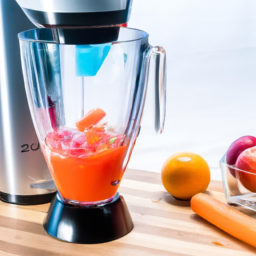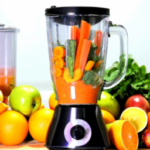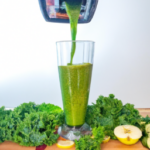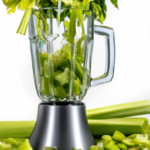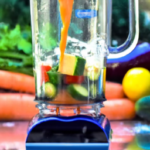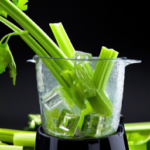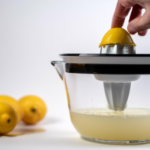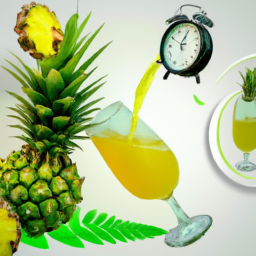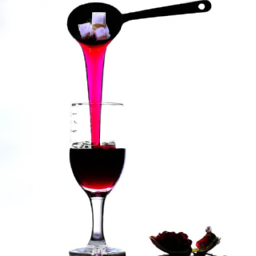I absolutely love using my Vitamix blender to make juice. It’s a simple and efficient way to incorporate a variety of fruits and vegetables into my diet, and it allows me to experiment with different flavor combinations.
In this article, I will share with you my tips and tricks for juicing in a Vitamix, so you can enjoy the benefits of fresh, nutrient-dense juice in your own home.
Juicing with a Vitamix is a great way to incorporate more fruits and vegetables into your diet, as it allows you to consume a large amount of produce in one serving. The high-speed motor of the Vitamix breaks down the fibers of the fruits and vegetables, making it easier for your body to absorb the nutrients.
Juicing with a Vitamix is also more cost-effective than purchasing pre-made juices or visiting juice bars, as you can use whatever produce you have on hand and customize your juice to your liking.
So, let’s get started on how to juice in a Vitamix!
Key Takeaways
- Juicing with a Vitamix is a convenient and cost-effective way to consume fruits and vegetables while retaining all fiber for digestion and weight management.
- When choosing produce, select the freshest and ripest produce for optimal taste and nutrition, and consider recipe ideas before shopping.
- Techniques for juicing with a Vitamix include washing and chopping produce, adding liquid for a smooth blend, and using natural sweeteners and spices for flavor and health benefits.
- To store and clean a Vitamix, use airtight containers to prevent oxidation, refrigerate juice to slow down oxidation, and clean the blender after each use with warm water and dish soap while avoiding harsh chemicals or abrasive scrubbers.
Benefits of Juicing with a Vitamix
Juicing with a Vitamix is not only convenient, but it also offers several benefits over traditional juicing methods. Many people opt for a juicer when looking to incorporate more fruits and vegetables into their diet, but a Vitamix may be a better option.
Unlike a juicer, a Vitamix retains all the fiber in the produce, which is important for digestion and weight management. This means that you get the same amount of vitamins and minerals in a Vitamix juice as you would in a traditional juicer, but with added fiber.
Another advantage of juicing with a Vitamix is nutrient retention. The high-powered blender breaks down fruits and vegetables, extracting more nutrients than a traditional juicer. This means that you get the maximum amount of nutrients from your produce, which is crucial for overall health and wellness. Additionally, the nutrients are easier to absorb into the body, as the blender breaks down the produce into a more digestible form.
When it comes to juicing with a Vitamix, choosing the right produce is important to ensure that you get the most out of your juice.
Choose the Right Produce
Picking out the freshest fruits and vegetables from the farmer’s market or grocery store will ensure a delicious and nutrient-packed blend for your homemade drink. When it comes to produce selection, shopping tips can make all the difference. Here are three ways to ensure you’re choosing the best ingredients for your Vitamix:
-
Look for seasonal produce: Choosing fruits and vegetables that are in season will not only taste better, but they’ll also be more affordable. Plus, seasonal produce is often packed with more nutrients since it’s been allowed to ripen naturally.
-
Choose ripe produce: When selecting produce, look for items that are ripe and ready to eat. For example, avocados should be slightly soft to the touch, while oranges should be firm and heavy for their size.
-
Consider recipe ideas: Think about the recipes you want to make before you shop for produce. This will help you choose the right ingredients and ensure that you have everything you need on hand.
Now that you’ve chosen your produce, it’s time to prepare it for blending.
Prepare Your Produce
Once you’ve brought your fresh produce home, it’s time to get it ready for blending by washing and chopping it into manageable pieces. Washing your fruits and vegetables is crucial to remove any dirt, debris, or chemicals that may be present. I recommend using a mixture of water and vinegar to wash your produce, as it is an effective and natural way to remove any unwanted substances. Simply fill a large bowl with water and add a splash of vinegar. Then, place your produce in the bowl and let it soak for a few minutes before giving it a good rinse under running water.
When it comes to cutting your produce, it’s important to use the right techniques to ensure that everything blends smoothly and evenly. For leafy greens, remove any tough stems and tear the leaves into smaller pieces. For harder produce like carrots or beets, chop them into small chunks to make blending easier. And for fruits like apples or pears, remove the core and any seeds before chopping. By taking the time to properly prepare your produce, you’ll ensure that your juice turns out delicious and nutritious. Now that your produce is ready, it’s time to add some liquid to the mix.
Add Liquid
To get started, you’ll want to add some liquid to your prepared produce for blending. Juicing without liquid can damage your Vitamix blades and burn out the motor, so adding liquid is crucial to achieve a smooth and consistent blend.
But what types of liquid can you use in juicing? The possibilities are endless! You can use water, coconut water, almond milk, soy milk, or any other type of milk. You can also add fruit juices, vegetable juices, or even green tea. The type of liquid you choose will depend on your taste preferences and the type of produce you are using.
For example, if you are making a green juice with lots of leafy greens, you may want to use coconut water to add some natural sweetness. On the other hand, if you are making a fruit smoothie, you may want to use almond milk for a creamier texture.
Now that you’ve added your liquid, it’s time to blend your ingredients. But before we move on, let’s take a moment to appreciate the importance of adding liquid to your juicing process. It not only helps achieve a smoother blend, but it also protects your Vitamix from damage.
So, let’s move on to the next step and blend our ingredients to create a delicious and healthy juice!
Blend Your Ingredients
Now it’s time to get blending and create a delicious and healthy concoction! Before you start, make sure your blender’s clean and well-maintained to ensure optimal performance.
Here are some steps to follow when blending your ingredients:
- Start with the softest ingredients, such as leafy greens or fruits, at the bottom of the blender jar.
- Add harder and chunkier ingredients on top to help push the softer ingredients down towards the blades.
- Use the tamper tool to push down any ingredients that are stuck to the sides of the jar or above the blades. This’ll help ensure everything blends evenly.
- Start at a low speed and gradually increase to a higher speed to achieve the desired consistency.
If you encounter any blending issues, such as chunks of unblended food or a stuck blade, try adjusting the order in which you add your ingredients or using the tamper tool to push the ingredients down further. If the problem persists, refer to your blender’s user manual for troubleshooting tips.
Now that your ingredients’re blended to perfection, it’s time to strain your juice to remove any pulp or fiber.
Strain Your Juice
Ready for a smoother, pulp-free drink? Let’s strain our blended mixture for an ultra-smooth texture. Juice straining is a crucial step in making a high-quality juice in a Vitamix. It helps remove the pulp and other unwanted particles, resulting in a liquid that is easier to drink and digest.
To strain your juice, you will need a fine-mesh strainer or a nut milk bag. Simply pour your blended mixture into the strainer or bag and let the juice drain through slowly. For a thicker juice, you can gently press the pulp with a spatula or spoon. Once the juice has passed through the strainer, discard the remaining pulp. Voila! You now have a delicious and refreshing juice that is perfect for any occasion.
Now that your juice is strained and ready to drink, it’s time to add some sweeteners or spices to enhance the flavor. Stay tuned for the next section where we will explore different ways to add sweetness and spice to your freshly made juice.
Add Sweeteners or Spices
Now that I’ve strained my juice, it’s time to add some sweeteners and spices to enhance the flavor. I like to use honey as a natural sweetener because it adds a subtle sweetness without overpowering the taste of the fruits and vegetables.
Cinnamon and ginger are two of my favorite spices to add because they not only add a delicious flavor, but they also have health benefits such as reducing inflammation and aiding digestion.
Honey
Don’t forget to add a drizzle of honey to your juice blend for a touch of natural sweetness. Using honey in juicing not only enhances the taste of your juice, but it also provides numerous health benefits.
Honey is packed with vitamins and minerals that are essential for our overall well-being. It has antibacterial and anti-inflammatory properties that help in healing wounds and fighting infections. Adding honey to your juice blend can also boost your immune system, improve digestion, and reduce the risk of heart diseases.
When using honey in juicing, it’s important to note that it should be added in moderation. Although honey is a natural sweetener, it’s still high in calories and can contribute to weight gain if consumed excessively. To keep the calorie count in check, limit the amount of honey you add to your juice blend. Additionally, make sure to use raw, organic honey as it’s less processed and contains more nutrients compared to regular honey.
Transitioning into the next section, another great way to add flavor to your juice blend is by adding cinnamon. Not only does it provide a warm and comforting taste, but it also has numerous health benefits.
Cinnamon
To add a little spice to your morning routine, try sprinkling some cinnamon into your favorite fruit and vegetable blends for a delicious and nutritious twist. Not only does cinnamon add a warm and cozy flavor, but it also comes with a range of health benefits that can boost your overall wellbeing.
Here are three recipe ideas to get you started:
-
Apple Cinnamon Smoothie – Blend together apples, almond milk, cinnamon, and a touch of honey for a tasty and satisfying breakfast on-the-go.
-
Cinnamon Carrot Juice – Combine fresh carrots, ginger, and a sprinkle of cinnamon for a refreshing and nutrient-rich juice that’s perfect for any time of day.
-
Cinnamon Sweet Potato Soup – Roast sweet potatoes with cinnamon, then blend with vegetable broth and coconut milk for a creamy and comforting soup.
Now, let’s move on to the next spice – ginger.
Ginger
Add a little zing to your recipes with ginger, a versatile spice that not only adds flavor but also has anti-inflammatory properties. Ginger is a great addition to your juicing routine as it offers many health benefits.
It’s been known to help with digestion, reduce nausea, and lower inflammation in the body. Ginger also contains antioxidants and compounds that help fight off infections, making it a great natural remedy for colds and flu.
If you’re looking for some tasty ginger juice recipes, try combining it with other fruits and vegetables for a refreshing and nutritious drink. You can mix ginger with carrots, apples, and oranges for a sweet and tangy juice, or blend it with kale and lemon for a green juice with a kick.
The possibilities are endless, so experiment with different combinations to find your favorite ginger juice recipe. And when you’re finished juicing, don’t forget to store your juice properly to keep it fresh and delicious for longer.
Store Your Juice
When storing your juice in a Vitamix, it’s crucial to use proper storing methods and preservation techniques. Our goal is to keep the juice fresh and maintain its nutritional value.
The best way to do this is by using airtight containers to prevent oxidation. Oxygen exposure can quickly deteriorate the nutrients in the juice, leading to spoilage. Therefore, it’s crucial to keep the juice container filled to the brim, leaving little to no air space.
Another tip for storing your juice is to keep it refrigerated. Cold temperatures will help slow down the oxidation process, keeping the juice fresher for longer.
If you’re looking to store your juice for an extended period, consider freezing it. Freezing the juice will help preserve its nutritional value and ensure that it’s still healthy to consume in the future.
Now that you know how to store your juice correctly, let’s move on to the next step of cleaning your Vitamix.
Clean Your Vitamix
Keeping your blender clean is essential for maintaining its longevity and ensuring that it functions properly. Deep cleaning your Vitamix after each use is crucial in removing any leftover residue and preventing any build-up of bacteria.
To begin, use warm water and dish soap to wash the blender’s container, lid, and tamper. For tougher stains or residue, you can use a mixture of warm water and baking soda as a natural cleaning solution. It’s important to avoid using harsh chemicals or abrasive scrubbers that can damage the blender’s surface.
Another important aspect of maintaining your Vitamix is to regularly inspect and replace any worn or damaged parts. The blade assembly, gasket, and drive socket are all crucial components that can wear out over time. Vitamix offers replacement parts for all their blenders, so it’s easy to keep your blender functioning like new.
By following these maintenance tips, you can ensure that your Vitamix blender lasts for years to come, and provides you with the best possible juicing experience. Now, let’s move onto the fun part – experimenting with different recipes and combinations!
Experiment with Different Recipes and Combinations
Now, let’s get creative in the kitchen and try out some new smoothie recipes to enjoy with your trusty blender! Don’t worry if you’re not sure where to start – there are endless possibilities and combinations to try.
To get started, here are three tips for juicing combinations:
-
Mix fruits and veggies: Don’t be afraid to mix your fruits with some veggies for a unique flavor profile. Try blending spinach, kale, and cucumber with some pineapple, mango, and banana for a refreshing green smoothie.
-
Add some protein: If you’re using your smoothie as a meal replacement or post-workout snack, consider adding some protein powder or nut butter to the mix. Peanut butter and banana is a classic combo that never disappoints!
-
Experiment with spices: Spices can add a whole new dimension to your smoothie. Try adding some cinnamon or ginger for a warming flavor, or turmeric for an anti-inflammatory boost.
By experimenting with different ingredients and flavors, you can find the perfect combination of fruits, veggies, and spices that not only taste great but also provide your body with the nutrients it needs. So, get creative and start juicing!
Frequently Asked Questions
How do I choose the right speed and setting on my Vitamix for juicing?
When juicing with a Vitamix, I choose the appropriate speed based on the produce I’m using – low for soft fruits and high for harder vegetables. I also adjust the settings for whole versus chopped produce.
Can I use frozen fruits and vegetables in my juicing recipes?
Frozen fruits and vegetables can be a great addition to juicing recipes. They retain their nutrients and are often more cost-effective. Use them in recipes that call for thicker textures, like smoothies, and avoid using them in recipes that require a juicer for optimal results.
How long can I store fresh juice made in a Vitamix?
Storing fresh juice is crucial to maintaining its nutritional value. To preserve freshness, refrigeration is recommended for up to 72 hours. Freezing can extend shelf life, but may affect enzyme activity and flavor retention.
Can I use my Vitamix for other functions besides juicing?
Yes, the Vitamix is incredibly versatile and can be used for a variety of functions beyond juicing. It can blend, puree, chop, and even make nut butters and soups. Its versatility is one of its key selling points.
What are some common mistakes people make when juicing in a Vitamix, and how can I avoid them?
To avoid common mistakes when juicing in a Vitamix, it’s important to use proper juicing techniques. These include using the right ingredients, blending in small batches, and straining the juice for a smoother consistency.
Conclusion
In conclusion, juicing with a Vitamix has numerous benefits for our health and wellness. With this powerful tool, we can easily create delicious and nutritious juices that are packed with vitamins and minerals.
By choosing the right produce, preparing it properly, and adding the right amount of liquid, we can create a juice that is both tasty and healthy. However, it’s important to remember that juicing isn’t a magic solution to our health problems. While it can be a great way to incorporate more fruits and vegetables into our diets, it shouldn’t be relied on as the sole source of nutrition.
By incorporating juicing into a balanced diet and exercise routine, we can reap the full benefits of this powerful tool. So, let’s grab our Vitamix and start experimenting with different recipes and combinations to create the perfect juice for our individual needs.
Ilana has been a vegan for over 10 years. She originally made the switch for health reasons, but soon found herself becoming more and more passionate about the ethical and environmental implications of a vegan lifestyle. Ilana is the author of The Graceful Kitchen, a blog all about veganism. She loves to cook up delicious and nutritious vegan meals, and share her recipes with others who are interested in leading a cruelty-free life. Ilana is also a strong advocate for using whole foods as the foundation of a healthy diet, and believes that going vegan is one of the best ways to achieve this.
